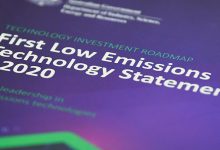The Morrison government has told Senate estimates that it has not ‘committed’ to achieving the emissions reductions detailed in the recently released Technology Roadmap, saying instead that they are mere ‘projections’ for the outcomes of investments in the government’s preferred technologies.
In Senate estimates, officials from the Department of Industry, Science, Energy and Resources were unable to detail the scale of funding that would be required to achieve the ‘stretch goals’ set under the Morrison government’s Technology Roadmap, including a claimed emissions reduction of 250 million tonnes.
“We haven’t necessarily backed that out to imply how much investment that was going to take,” department deputy secretary Jo Evans told the hearing.
Trade minister Simon Birmingham, who represents energy minister Angus Taylor for Senate hearings, suggested that the Morrison government wasn’t required to outline the costings or details of how the claimed emissions reductions were going to be achieved, as the Technology Roadmap detailed a series of ‘projections’, rather than ‘commitments’, for what may be achieved beyond 2030.
“What we have in this Tech Roadmap is projections. Projections based indeed on a series of assumptions… but they are projections. What we have made in relation to 2030 is a commitment to a target, a commitment to achieve it,” Birmingham said.
“Don’t confuse commitments with projections that are in documents underpinned by a series of assumptions.”
“Don’t conflate the differences between the commitments we’ve made under 2030 as part of the Paris Agreement, that we have modelled and demonstrated how we will achieve, verses projections as to where we think the Technology Roadmap can go, which will be updated as the Tech Roadmap makes clear, as we continue our investments in it,” Birmingham added.
The First First Low Emissions Technology Statement, released as part of the government’s technology roadmap, claimed that the plan would avoid ‘250 million tonnes of emissions per year by 2040’. However, the Morrison government has not set an emissions reduction target beyond 2030, and has refused to commit to a net zero emissions by 2050 target, as has been adopted by every Australian state and territory.
Labor senator Jenny McAllister said it was astonishing that the Morrison government was now differentiating between commitments and projections for emissions reductions, and that the government was claimed a ‘free-pass’ from having to detail the costings of its emissions reduction policies.
During estimates, department officials confirmed that the government would continue to reform the two key funding bodies established under the Gillard government, the Australian Renewable Energy Agency (ARENA) and the Clean Energy Finance Corporation (CEFC), to deliver on most of the government’s priorities, including planned investments in carbon capture and storage technologies.
Officials said that in addition to amendments being considered to the CEFC’s legislation, a further package of legislative changes would soon be forthcoming to align the investment mandates of both ARENA and the CEFC with the government’s technology roadmap.
“The government has been very clear through the Technology Roadmap, that its intent is to align the mandate for ARENA and the Clean Energy Finance Corporation so that they can support, in a very technology neutral way, the technologies that are envisaged in the roadmap,” Evans said.
This will include opening up both agencies to allow them to provide funding for carbon capture and storage technologies, in addition to a $50 million fund for carbon capture technologies that will be administered by the industry department.
“The current [CEFC] Act prohibits carbon capture and storage,” Evans said. “The government has said also publicly that its intention is to amend the mandate of the CEFC and that of ARENA to be able to support the Low Emissions Technology Roadmap, which includes carbon capture and storage. So that is one other part of the amendments that are coming.”
ARENA CEO Darren Miller said that ARENA’s future funding priorities, to be reviewed when $1.4 billion in new funding starts flowing from 1 July 2023, would be aligned with the priorities outlined by the government’s Technology Investment Roadmap.
“Our board retains its independence, and so it’s up to the ARENA board to ultimately set the direction for the agency,” Miller said. “But clearly, the Technology Roadmap process and the Low Emissions Tech statement give us some key pointers as to where to apply our funding for that pool of money for the future.”
“As we stand right now, our investment priorities are around integrating renewable energy into the grid, around renewable hydrogen for domestic and export potential, and supporting industry to reduce emissions. And with the roadmap having been released, we are taking the opportunity to review our investment priorities and our strategy in light of the roadmap,” Miller added.
Miller confirmed that ARENA’s new funding would be provided on a rolling basis through budget appropriations.
In the federal budget unveiled in October, ARENA was allocated an additional $223.9 million over the four years to 2023-24. Under this arrangement the remaining funding, promised to be delivered over ten years, would need to be provided through future budget allocations, rather than being guaranteed, as previous funding was, by being included within the ARENA Act itself.
Miller also told senate estimates that ARENA was still engaged in negotiations with a potential pumped hydro energy storage facility planned for South Australia.
In August 2019, ARENA said that up to $40 million in funding would be allocated to fast track the construction of a pumped hydro storage facility, with a minimum capacity of 200MW, but no further details of the project have emerged since that initial announcement.
Miller said that difficulties on the part of the project proponents, including disruptions relating to Covid-19, had delayed the finalisation of the funding agreement, but that negotiations were ongoing.










